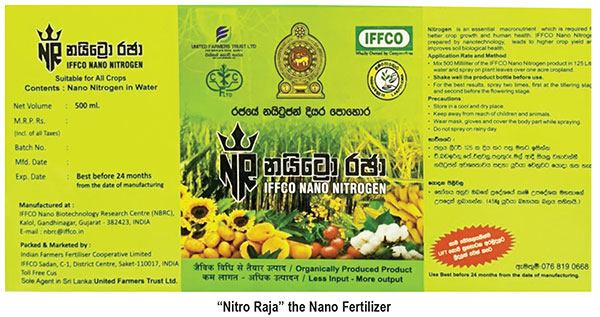‘Nitro Raja’: Magic Fertiliser arrives!
Posted on October 27th, 2021
By Dr PARAKRAMA WAIDYANATHA Courtesy The Island
The consignment of nano urea, much spoken about produced by Indian Farmer Fertiliser Corporation (IFFCO}, had just arrived! Locally it is named Nitro Raja!” Can the imported Raja settle our fertiliser woes, where the ‘local Raja’ has hitherto failed?
What is nano urea, many people ask! For the layman it may best be described as something akin to Seeni- polkohu” or Bombai-motai”, where sugar particles are attached to a fibrous material. Similarly, in nano urea, the urea molecules are attached to oligosaccharide (examples, starch and sugar) molecules. This greatly enhances the efficacy of the applied urea to crops.
The advantage is that, whereas urea when applied to the soil, often much of it is wasted through leaching, run-off in rain water and vaporisation, losses are very small with the nano formulation. Even normal urea if applied to plants as a leaf spray in good weather, the losses are far less than application to the soil. Up to a maximum of 5% of chemical nutrients can be applied as foliar spray, and in fact urea is, for example, routinely applied in tea plantations usually mixed with zinc sulphate, which research has reported, to boost crop yields substantially.
Regrettably the imported consignment apparently is exclusively for rice cultivation. Is it because the tea growers were not as vociferous and violent as the rice farmers in their demonstrations and ministerial effigy-burning? Ideally, for the tea growers, too, urea is critically important. As most would have applied all nutrients over the years, the soil reserves of nutrients should suffice to tide over an year or more except for nitrogen, the most yield determining nutrient; and the current huge tea crop losses could have been saved, if at least urea in whichever form were supplied to the tea industry.
The critical issue is, however, whether at the recommended rate, the imported nano urea could effectively meet the crop nitrogen demand. It is imported in 500 ml bottles and each bottle content, the advertisement says, is equivalent to a 50 kilo bag of normal fertiliser urea. Nevertheless, it is further stated in the advertisement that the contents has a nitrogen(N) concentration of only 4%, whereas normal urea has 46%.
Meeting Demand?

Let us see whether the supplied nano urea can meet the crop nitrogen demand at the prescribed application rate. The national average yield of rice is now 5 tons /hectare. Therefore, an average rice crop by way of grain and straw removes about 80 kg/ha, and the normal rate of application of nitrogen for a good rice crop is 100kg/ha . So, in whatever way the crop is fertilised (with nano urea or normal urea) a 5 ton rice crop/ha should remove a minimum of 80 kg of nitrogen. Theoretically, however, the recommended nano-urea formulation imported can only provide 20 grams of nitrogen per 500 ml bottle, and to provide the requisite nitrogen of 80kg/ha to the crop, therefore, 4000 such bottles should be applied! The cost of a 500 ml bottle is reported to be Indian Rs 240, which is about local Rs 500. Theoretically then, the nano fertiliser per crop to provide the entire crop nitrogen requirement should cost two million rupees! Can this nano urea then practically meet the total crop nitrogen demand ?
The crux of the matter is that, in India, where nano urea is used, usually a basal application of conventional urea is made to the crop, and nano urea is only sprayed at mid- maturity as a foliar spray for boosting the crop.
The other serious concern is that when nano urea is spayed as the crop is growing, the emerging weed growth in the absence, now, of the two standard herbicides used in rice, one before crop emergence (usually Propanil) and the other ( MCPA )when the crop is in early growth(post emergent), could be substantial. Nearly 95% of the rice growers broadcast seed, and hand weeding is difficult in such crops. Row seeding is highly labour demanding and row seeders are costly. Much of these weeds are highly competitive C4 grasses and sedges, which too will benefit from the foliar nano urea spray and increase the competitiveness, reducing the crop yield!
One of the growing concerns today, globally, in the fertiliser scenario is, not whether it is organic or chemical, but with the grain production anticipated to increase by at least 40% in the next decade and 60% of the nitrogenous fertiliser used for it, the devastating environmental AND pollution issue . Many argue the answer is in cutting down meat consumption as bulk of the grain in the developed world is used as animal feed!
However, there is already technology generated for improving N management practices at the farm level, and nitrogen uptake efficiency (NUE) increases of 36% and 32% have been achieved in the U.S and Japan respectively in the last few decades; one of them being nano fertilisers. With novel plant breeding and fertisier technologies many scientists envision reaching 90-100% NUE in the near future.